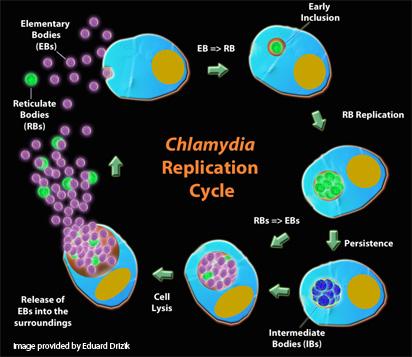Research
 The Chlamydiaceae are a family of obligate intracellular bacteria. Among them are two important human species, Chlamydia trachomatis and Chlamydia pneumoniae. C. trachomatis has several serotypes and is the most common cause of bacterial sexually transmitted disease worldwide. C. trachomatis is also the leading cause of preventable blindness worldwide. C. pneumoniae is responsible for ~15% of community acquired pneumonia cases and has been implicated in several chronic diseases including asthma, arthritis and atherosclerosis.
The Chlamydiaceae are a family of obligate intracellular bacteria. Among them are two important human species, Chlamydia trachomatis and Chlamydia pneumoniae. C. trachomatis has several serotypes and is the most common cause of bacterial sexually transmitted disease worldwide. C. trachomatis is also the leading cause of preventable blindness worldwide. C. pneumoniae is responsible for ~15% of community acquired pneumonia cases and has been implicated in several chronic diseases including asthma, arthritis and atherosclerosis.
Chlamydial organisms are also a frequent cause of abortions, pneumonia, conjunctivitis, encephalomyelitis, polyarthritis and infertility in livestock. Chlamydiae have been isolated from milk samples and mammary tissues from dairy cows affected by mastitis as well as frozen semen samples. Chlamydial infections in cattle are an emerging economic burden worldwide and infections range from an asymptomatic state with intermittent shedding of the organism, to overt clinical disease and mortality.
There is no efficacious vaccine to prevent chlamydial infections in either human or animals and there have been no human Chlamydia vaccine trials since the 1960s. This highlights the difficulty of designing an effective Chlamydia vaccine.
Our research has focused on the following goals: (1) understanding the role and mechanism of Chlamydia involvement in chronic respiratory diseases. Our lab has confirmed that C. pneumoniae is involved in the exacerbation of asthma and plays an etiologic role in non-eosinophilic or non-allergic asthma. This asthma phenotype is characterized by significant neutrophil infiltration into the airways and recent reports confirm that half of all asthmatics have a non-allergic phenotype that is not well controlled with inhaled corticosteriods treatment. Our lab is currently focussed on better understanding the underlying mechanisms involved in this inflammatory process with the hope of designing/defining better treatment regimens for this critical subset of severe asthmatics.
 (2) Design and development of a multi-subunit vaccine to prevent chlamydial infections. Our lab is using the gas vesicles of Halobacteria as a platform for multi-subunit antigen display and have confirmed that this system is a potentially effective display and delivery platform for antigens of chlamydial vaccine interest.
(2) Design and development of a multi-subunit vaccine to prevent chlamydial infections. Our lab is using the gas vesicles of Halobacteria as a platform for multi-subunit antigen display and have confirmed that this system is a potentially effective display and delivery platform for antigens of chlamydial vaccine interest.

